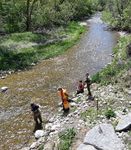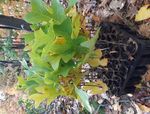Bring Back the Salmon - Lake ...
←
→
Page content transcription
If your browser does not render page correctly, please read the page content below
Newsletter of the Lake Ontario Atlantic Salmon Restoration Program
Winter 2021
ILLUSTRATION: CURTIS ATWATER
Newsletter
Bring Back the Salmon
BBTS tidbits This macroinvertebrate
(Order Megaloptera:
Jeff Dickie
dobsonflies) captured an
captured
Atlantic Salmon fry.
this
Dobsonfly larvae, also
amazing
known as hellgrammites,
photo of an
are top invertebrate
Atlantic
predators, and can live up
Salmon
to five years.
jumping at
a Humber
River weir.
Art throwback from
a classroom hatchery
participant.
BBTS has a YouTube channel! Watch our educational
videos and underwater footage of fishes in our restoration
streams: https://www.youtube.com/user/LOASRP
Stay connected with
Bring Back the Salmon
by following us
@ontariosalmon.Education and outreach
Classroom hatchery program goes virtual
Due to concerns for health and school access restrictions caused by
COVID-19, we will run our classroom hatchery program virtually this
year. The program will have two hatchery tanks set up at the OFAH
Mario Cortellucci Hunting and Fishing Heritage Centre. Here we will
run 30-minute video sessions for 15 weeks with presentations related
to the biology, ecology, and history of Atlantic Salmon. The students
will observe the fish develop from eyed eggs to fry and teachers can
schedule a live question and answer session with our biologists.
This program offers excellent educational opportunities connected to
fish biology, natural and cultural history, habitats, ecosystems, and
environmental stewardship. In May we will go on a virtual field trip to
release the fish in a local restoration stream. Teachers will be supplied
with curriculum-linked lesson plans about Atlantic Salmon to use
throughout the year. We will cover more of the natural history,
science, and human impact components than we can during our regular
program. We hope to return to our regular program in 2022. Visit
http://www.bringbackthesalmon.ca/classroom-hatchery-program/ to New classes
download lesson plans and watch our videos.
An Ontario Trillium Foundation (OTF)
Grow Grant has made it possible for us to
add 10 new classes to our program this
year from Durham, Northumberland, and
Peterborough regions. A total of 30 new
The virtual program is available classes have been added over the past 3
to any grade from any location! years through the generous support from
For more information on the OTF. The new classes will participate
virtual program please contact virtually this year and will join the
Ben (ben_teskey@ofah.org). regular program post COVID-19.Research and assessment
Adult assessment
The two Vaki Riverwatcher fish counters (Corbett’s Dam on the
Ganaraska River, and Streetsville Dam on the Credit River) were
installed later than usual in 2020 due to COVID-19 restrictions, but
should have captured the full Atlantic Salmon migration season.
Staff also used underwater cameras and walked sections of Cobourg
Creek to document adult numbers and behaviour. Redd digging and
spawning were seen in November in prime spawning habitat.
We also had reports of adults in Bowmanville Creek, Shelter Valley,
Oshawa Creek, and Wilmot Creek, all non-stocked locations.
Top: An Atlantic Salmon returning
Check out our YouTube channel for videos of fish behaviour, redd through the Credit River fishway
building, and spawning. Watch videos of the fish migrating through camera on August 14, 2020. Bottom:
the fishways at at www.riverwatcherdaily.is/rivers. An Atlantic Salmon moving through the
Ganaraska River fishway counter on
Throwback: Did you know that September 7, 2020.
we used a resistance board weir
(pictured to the left) in Duffins
Creek from 2013-2015 to count the number of returning adults? This
temporary structure blocked fish and directed them to a holding cage where
they could be counted and released.
New research
Larocque et al. (2020) compared diet and abundance of
juvenile Atlantic Salmon to other fishes within stocked
streams. Strong competition occurs when an abundant
species has a similar diet. Only weak competition was
found, as juvenile Brown Trout had similar diets but low
abundance; Blacknose Dace, juvenile Rainbow Trout, and
Rainbow Darter had somewhat similar diets but also had
low abundance; and Brook Trout, Longnose Dace, Mottled
and Slimy Sculpin, and Longnose Dace were more
Simon Amyotte abundant but had dissimilar diets. Thus, competition with
juvenile salmonids
Thank you to all the anglers who submitted reports and adult minnows
of their Atlantic Salmon catches. These give us is not limiting the
important information on timing and location. success of juvenile
Remember to practice proper catch-and-release Atlantic Salmon.
techniques like pictured here – keep fish wet! Paper available at: https://doi.org/10.1139/cjfas-2020-0204Fish production and stocking
Adult broodstock
MNRF continues to stock surplus broodstock into Lake Ontario at Bronte
Harbour, Port Dalhousie, Cobourg, Newcastle, Grimsby, and Port Hope
since 2018. These fish have a floy tag inserted below the dorsal fin. The
colour and number on the tag corresponds to release location. Of the 1915
fish tagged, 94 (4.9%) have been caught so far. In addition to providing
additional recreational fishing opportunities, angler reports of these tag
numbers will continue to provide information on movement. Check out
https://tinyurl.com/y3rctevg for all the information.
Throwback (above) to
stocking Duffins Creek in
2018. We do not know
whether we will be able to
have volunteers this May to
help stock spring fry, so stay
tuned to our social media
channels for updates.
Above: The fish icons indicate capture location, and their colour corresponds to
stocking location (pins). Off the map, one fish tagged at Grimsby was captured
at Lake St. Francis (east of Cornwall). Stocking update
In 2020, we stocked 125,000 spring
yearlings both upstream in our
standard stocking locations, and at
the mouths of the Credit and
Ganaraska Rivers. River mouth
stocking is used in several other
jurisdictions and we anticipate
seeing higher returns from this
A reminder that Atlantic method in fall 2021 (3-year old
Salmon are catch-and-release adults) and fall 2022 (4-year old
only in Fisheries Management adults). We also stocked 368,500
Zones 16 and 17. Know your spring fry and in the Credit River,
species ID and practice Humber River, Wilmot Creek, and
responsible angling. Visit Duffins Creek, and 65,000 fall
www.bringbackthesalmon.ca fingerlings in the Credit River and
for more information. Duffins Creek.Water quality and habitat enhancement
Tree plantings
Thanks to support from TD in 2020, the BBTS habitat
team and partners tackled four coldwater stream
reforestation restoration projects on Duffins Creek and
Bronte Creek. A total of 462 native trees and shrubs were
planted through the Friends of the Environment
Foundation, while TD Tree Days funds were reallocated
to public land on Duffins Creek, with 900 trees and shrubs
planted by Toronto and Region Conservation Authority
staff. These trees will increase forest cover, decrease
stream temperature, and improve stream bank
stabilization, benefitting many aquatic and terrestrial
species by improving the health of the streams.
Above: Land on Duffins Creek had 900 trees and
shrubs planted.
DFO also funded tree planting through their Habitat
Stewardship Program for Aquatic Species At Risk for
Silver Shiner habitat. In fall 2020, 835 trees were
planted along Limestone Creek (a tributary of Bronte
Creek) which supports Silver Shiner, Atlantic Salmon,
and other coldwater species. Threats to these species
include increased sedimentation and elevated water
temperatures, which riparian plantings help reduce.
Courtcliffe (bottom) and Riverview (top left) Parks on
Bronte Creek and Transport Canada lands (top right) on
Duffins Creek had trees and shrubs planted by OFAH and
partner staff.You can also read



























































